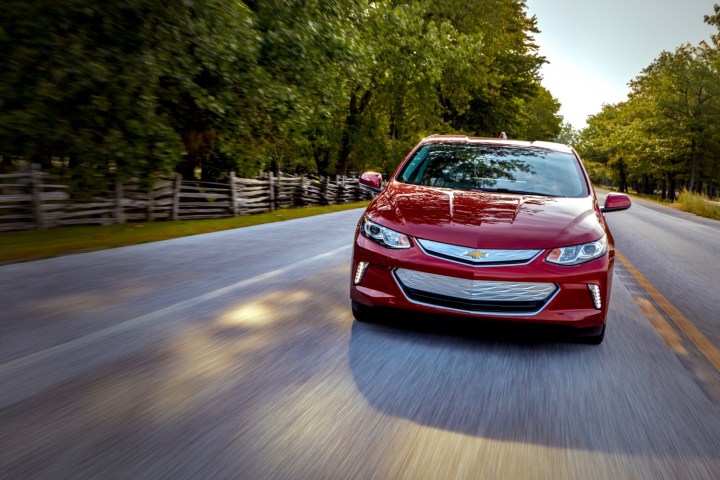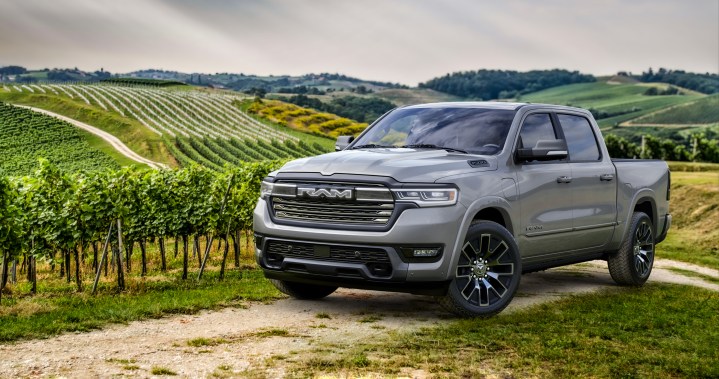We’re all familiar with traditional internal combustion engine (ICE) vehicles and electric vehicles (EV), but there are actually vehicles that are kind of in between the two. The most common is the plug-in hybrid electric vehicle (PHEV), which has a smaller electric battery that’s designed to allow a vehicle that would otherwise be gas-powered only to drive shorter distances on electric power or to improve their gas mileage by combining the two.
The PHEV approach is still largely gasoline-first, considering the fact that its electric range is typically very low, and much of the time PHEV drivers will end up using their vehicle in hybrid mode anyway — not to mention the fact that the electric motors often aren’t that powerful.
But there’s another hybrid vehicle type that takes an additional step toward a fully electric vehicle, and is a better option for drivers who want to go fully electric, but are concerned about range. The extended range EV, or EREV, isn’t gasoline-first. Instead, it’s electric-first, offering a full-size electric battery and one or multiple powerful electric motors. So what makes an EREV hybrid? Well, on top of that electric powertrain, an EREV has a small gasoline generator that’s built exclusively to charge the battery. The gas generator can’t actually power the wheels at all, but it can extend the range of what would otherwise be a fully electric vehicle, helping eliminate range anxiety while serving as a fallback in emergencies.
The next stop toward electrification
While electric vehicles have become a whole lot more common over the past five years or so, there are still plenty of drivers who aren’t willing to make the switch. It makes sense. EV ranges are getting better, but a fully charged EV still won’t offer the same range as a gas-powered vehicle with a full tank of gas, for the most part. Not only that but drivers are used to being able to refuel in a matter of a few minutes, and while EV charging speeds are getting better, even the fastest EVs can still only charge in around 20 minutes.

PHEVs solved that, but in a way that probably isn’t all that satisfying for those who want an electric vehicle but can’t quite figure out how to make integrating one into their lives convenient. After all, PHEVs are basically more economical gas-powered cars, and while you might be able to get away with driving on a charge to and from work, it only really makes sense for those who can charge at home — at which point, it almost makes sense to just go all-electric.
“The pure-EV range on most PHEVs is too low to satisfy many buyers who’d want an EV, and many buyers who just wanted to save money on fuel aren’t even bothering to plug PHEVs in regularly enough to take full advantage of its all-electric-mode benefits,” said Stef Schrader, news editor at Cars.com, in an interview with Digital Trends. “At that point, it makes more financial sense for that latter category of buyers just to get a regular, non-plug-in hybrid that costs less and doesn’t lose efficiency from carrying around plug-in equipment that never gets used.”
EREVs are much more of a step in the direction of electrification, and they solve a number of issues. While you arguably would still want to be able to charge at home with an EREV, it starts to become a little less of an issue when you have a longer range and wouldn’t need to go to a charging station as often. Not only that, but EREVs help make the idea of road trips a little more palatable, and many drivers could essentially use an EREV as an electric vehicle the vast majority of the time, only relying on the gas generator on road trips where a longer range is necessary.

“I expect EREVs to become more common in the intermediate future,” said Bilin Aksun Guvenc, research professor of mechanical engineering at Ohio State University, in an interview with Digital Trends. “Unless there is a major breakthrough in battery technology, battery electric vehicles (BEV) will always suffer from their short range and the range anxiety they cause.”
Still a stopgap?
Of course, to be clear, EREVs could still be a stopgap toward full electrification, but a stopgap that makes sense longer term, for certain drivers. Many experts predict that true EVs won’t get much wider adoption until there are a few breakthroughs in EV battery technology that give them a longer range and faster charging speed.

But the need to turn away from fossil fuels is more urgent than that, and plenty of climate-conscious drivers would switch to a fully electric vehicle if it didn’t mean making significant compromises to their lifestyle. That’s especially true for those who can’t charge at home.
“There will always be part of the population who will want to keep their internal combustion engine vehicles with their sometimes overpowered powertrains. Their stopgap solution is hybrid electric vehicles that still have a sizable internal combustion engine aided by a small electric motor at low speeds and as power assist or fuel economy are needed,” continued Aksun Guvenc. “EREVs are a stopgap solution for the public who are willing to go fully electric but are adversely affected by the range problem.”
Eventually, though, EVs will hopefully eliminate the need for stopgaps altogether. There are plenty of battery technologies in the works, chief among those being solid-state batteries. Solid-state batteries are tipped to bring much longer ranges to electric vehicles and could charge at much faster rates too without damaging battery chemistry.

Widespread adoption of these new technologies could take some time. Solid-state tech will hopefully roll out in the next few years, but initially, it will be reserved for luxury vehicle manufacturers that can justify spending more on a new technology. Over time the tech will get cheaper, but it may not be until the early 2030s before EVs have fully switched to the new tech, even in more affordable vehicles.
EREV downsides
There are some things that EREVs don’t solve for though. The longer range means that EREVs won’t necessarily need to be charged as often, but if you want to achieve that longer range each time you refuel, there’s a different inconvenience you’ll need to consider: having to both charge and refill the gas tank. To be fair, most drivers probably won’t use an EREV like that, instead using it as an all-electric vehicle most of the time, then having the gas generator kick in on longer road trips or when their battery happens to run low.
That’s really the ideal use case of an EREV, and those who can charge at home will find it even easier. These drivers will be looking toward an EREV simply as an option for road trips instead of in day-to-day use as a way to avoid charging quite often.
Another big downside, of course, is the use of gasoline in the first place. If you can’t charge at home, you could potentially use an EREV like a low-range gas vehicle, relying on the generator to charge the battery instead of ever plugging the car in. Of course, in that situation, you’ll need to ensure that your EREV can generate more power than you use when you’re driving, so that the battery can actually charge up. Ultimately, though, in that situation, you might as well not have an electric vehicle at all.

EREVs still need to be charged though, and the biggest issue with wider adoption of any kind of electric vehicle is a lack of charging infrastructure. If you’re in a situation where you can charge at home, this isn’t as much of an issue for you, and you should think seriously about buying an EV or EREV next time you’re in the market for a new car. Those who don’t own their home, though, may be a little more cautious, and it makes sense. We still need more chargers in locations like apartment complex parking lots.
Oh, and the combustion engine and associated components? Those add cost, and perhaps more importantly, weight.
“You are adding an internal combustion engine with its drivetrain to drive the electric motor or charge the battery, albeit being a small one as compared to a series HEV. This will add cost,” said Aksun Guvenc. “The new components that are added also take space and add weight to the vehicle. The extra weight will reduce the pure BEV range slightly. An EREV is a very mild series HEV and the full potential of an electric vehicle can only be used if the vehicle is fully electric.”
One last downside to EREVs is that they’re not widely available just yet. Scout Motors just announced two new models in the form of the Scout Terra and the Scout Traveler SUV, both of which will have an EREV option when they’re released in a few years. Before then, we’ll see the Ram 1500 Ramcharger, which will have an EREV option, and should be released sometime in the next few months. But until then there aren’t really any EREVs currently available in the U.S., unless you buy a used Chevrolet Volt.
The outlook on EREVs
It’s true to say that EREVs are a stopgap toward full electrification, which is where we’re headed. Forget other fuel types. Vehicle manufacturers have invested too much into electric vehicles for things like hydrogen-powered vehicles to ever become realistic.

“It’s hard to say whether EREVs will become dominant in the market — you still need to plug them in, so they’re really best viewed as an EV with a generator attached — but it would not be surprising if more automakers gave them a whirl,” Schrader said. “There’s still a big international regulatory push to reduce automotive emissions and move towards electrified drivetrains, and being able to recharge an EV’s battery in a pinch using regular gasoline makes it easier to take trips to rural or remote areas where charging infrastructure simply isn’t there.”
Shrader also thinks that EREVs could solve another problem for some drivers — limited range away from civilization. According to Schrader, rugged off-road-ready SUVs have become more of a trend in recent years, and in off-road environments it’s less likely you’ll have a fast-charging station nearby.
Until EVs have longer ranges and can charge faster, there are plenty of people who need a stopgap and who won’t be willing to switch to an all-electric vehicle. Drivers who can charge at home but aren’t quite willing to jump to a full EV may find that the EREV is the perfect alternative.




